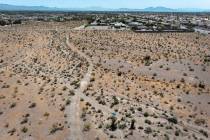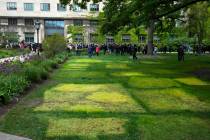Nevada researcher reveals Antarctic’s dirty secret
When Norwegian explorer Roald Amundsen and his team reached the South Pole on Dec. 14, 1911, they had every reason to believe they were in a place untouched by mankind.
A new study led by a researcher from Nevada’s Desert Research Institute proves they were wrong.
Air pollution from industrial activity thousands of miles away beat Amundsen to the South Pole by roughly two decades, seeding the snow and ice at the farthest reaches of the globe with traces of lead that continue to collect today.
Using ice core samples from 16 different sites in Antarctica, DRI snow hydrologist Joe McConnell and an international team of scientists have assembled the most complete picture yet of lead pollution across the continent. They also confirmed for the first time the presence of the toxic heavy metal from industrial activity in ice collected at the South Pole itself.
Their detailed record, described in an article published online this week in the research journal Scientific Reports, spans more than four centuries, from 1600 to 2010. For the first 289 years studied, lead concentrations in the ice mostly bounced along at levels considered below average.
They suddenly spiked in 1889.
“It’s literally like turning on a light switch,” McConnell said.
The abrupt rise in pollution perfectly coincides with development of a large lead mine in South Australia. McConnell said the mine at Port Pirie opened in 1883, and a smelter added in 1889 continues to operate today.
That was one of the most surprising results of their analysis.
“A single industrial complex was enough to contaminate the entire continent of Antarctica thousands of kilometers away,” he said.
Researchers estimate some 660 metric tons of lead — or 1.5 million pounds of the stuff — has fallen on the southern continent in the past 130 years.
“That’s a lot,” McConnell said.
LEGACY OF LEAD
Lead levels declined noticeably during World War II, when industrial production in Australia and elsewhere in the Southern Hemisphere ground to a halt. Then the levels “came roaring back in the leaded gasoline era” after the war, McConnell said.
The amount of lead McConnell and company found in the ice cores peaks at six to seven times normal background concentration. The levels began to decline in the late 1970s and early 1980s, as the health risks associated with lead gained wide attention and its use in gasoline and other products slowed worldwide.
Interestingly, McConnell said, record-high levels occurred around 1910, making the South Pole Amundsen trekked to as polluted as it has been in the past 410 years.
But despite improved emissions technology and a reduction in lead use, contamination continues. Even the most recent samples collected from 2010 show several times as much lead as there was before that initial spike in the late 19th century.
“We’re still polluting Antarctica today,” said McConnell, who is also director of the special laboratory on DRI’s campus in Reno, where the samples were analyzed.
So why does an organization called the Desert Research Institute have an ice core lab in Nevada and researchers at the South Pole?
Because the research arm for the state’s system of higher education doesn’t just study deserts any more, DRI spokesman Justin Broglio said. The institute now conducts a wide range of applied research across the globe.
But if you want to get technical about it, McConnell said, “Antarctica is the driest continent on Earth,” with some places that see far less precipitation in a year than Las Vegas does. In other words, much of the southern continent is considered a desert, albeit a very cold one.
REACHING THE POLE
McDonnell said he has now made “four or five” trips to Antarctica, the most recent of which had him ringing in the arrival of 2014 at the bottom of the world. He hopes to go back for an upcoming French-Italian expedition to the pole because “they serve the best food,” he said with a laugh.
McConnell also has plans for a similar analysis of lead in ice from the North Pole and elsewhere in the Arctic.
He said the South Pole is about how you would expect: cold, occasionally very windy and not much to look at.
“I tell people it’s like Kansas (in winter). It’s completely flat and white,” he said. “It’s half an inch of powder on a two-mile base.”
There’s also an inescapable sense of history. You can’t be there without thinking of those first explorers and what they had to endure to survive.
“We think we’re tough when we ride around in our heated vehicles. They were tough,” McConnell said.
It took Amundsen and four fellow explorers more than three months to trek to the South Pole and return to base camp with about 40 fewer sled dogs than they had at the start.
By contrast, one of McConnell’s trips to Antarctica took 14 days, including 11 at the pole in a heated research station that accommodates dozens of researchers. He took a flight from the United States to New Zealand, where he hopped a military transport to Antarctica’s famed McMurdo Station. And from there he took a 2½-hour flight to the pole on an LC-130 cargo plane equipped with skis so it can land on snow and ice.
On one of his days there, the temperature outside the domed research station hit 100 below zero, with the wind chill. Instead of freezing to death, he and his colleagues poured themselves more coffee and waited for the weather outside to warm up.
“By most people’s standards, it’s still pretty adventurous,” he said. “But I’ve still got my fingers and my nose.”
IMPORTED ICE
Getting ice cores back to Reno isn’t easy. The samples drilled from the ice pack are about 4 inches in diameter and 100 to 500 feet long. They were divided into 3-foot sections that were placed six at a time in boxes that each weighed more than 100 pounds when full.
McConnell said the cores were flown from the collection sites to the Antarctic coast and loaded onto ships bound for California. There they were placed in a refrigerated truck. A second, empty truck followed the ice all the way to Reno, just in case of a breakdown. That might seem like a ridiculous expense, he said, but “it’s cheap compared to the cost of getting the cores in the first place.”
DRI keeps the core samples at a commercial frozen storage facility in downtown Reno, stacked alongside the frozen shrimp and French fries served at restaurants in the area.
Sections are cut from the cores and melted so chemicals trapped in the ice can be measured and analyzed. If researchers are careful, they can use a single ice core in numerous experiments over several years.
If there is one thing people should take away from the pollution findings, it’s this, McConnell said: “What we do matters,” even at the ends of the Earth.
Contact Henry Brean at hbrean@reviewjournal.com or 702-383-0350. Follow @RefriedBrean on Twitter.
To read the full report, click here





























